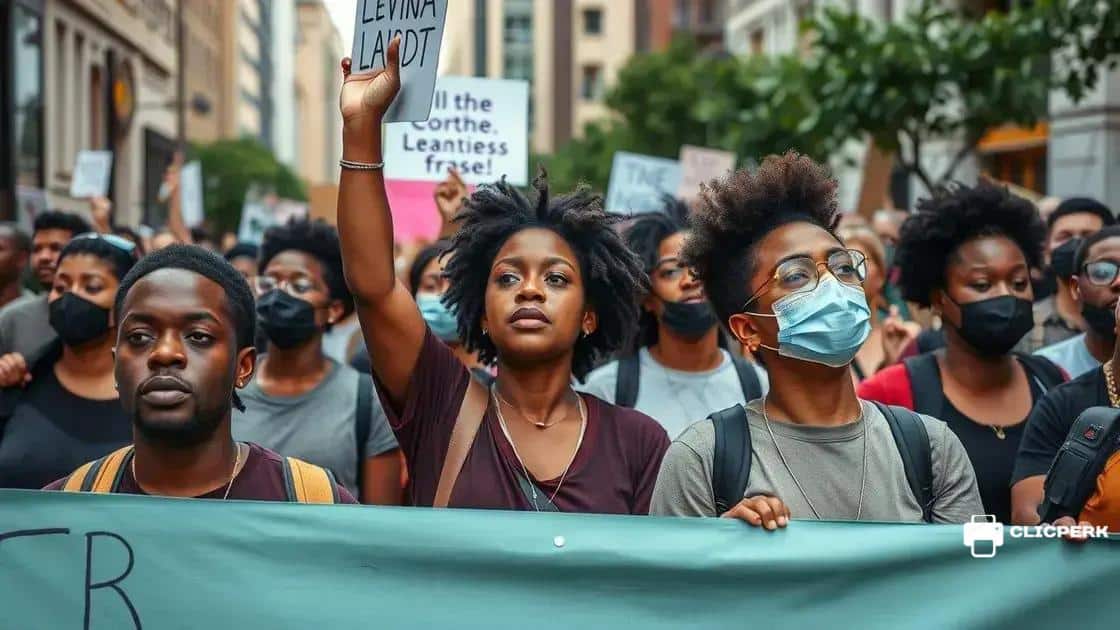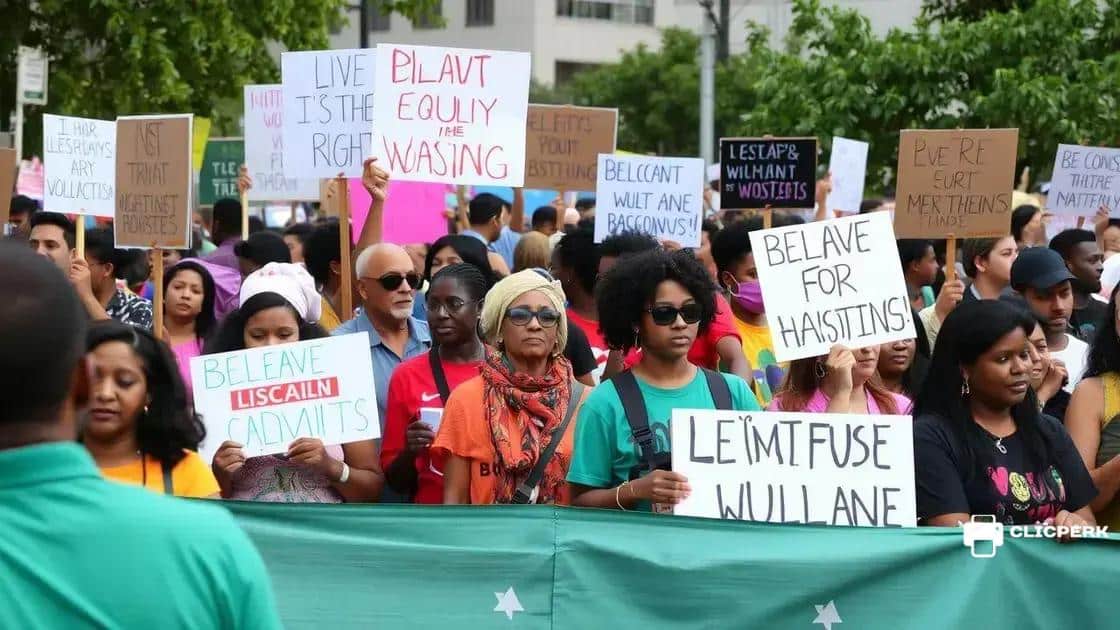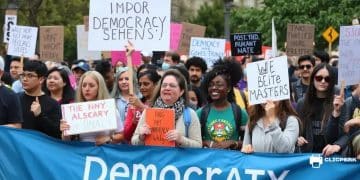Civil rights advocacy movements: a journey through history

Civil rights advocacy movements aim to promote equality and justice, addressing challenges through grassroots efforts, technology, and a focus on intersectionality, shaping a more inclusive future.
Civil rights advocacy movements play a crucial role in shaping society. Have you ever wondered how these movements take shape and evolve? In this article, we’ll delve into their history and ongoing significance.
The origins of civil rights advocacy
The origins of civil rights advocacy can be traced back to the early struggles for equality. Throughout history, individuals have fought against oppression and injustice, striving for basic rights and freedoms. Understanding the roots of these movements is essential to appreciate their impact.
The early movements
In the early 20th century, several organizations emerged to tackle discrimination. Activists worked tirelessly to voice the concerns of marginalized communities. Their efforts laid the groundwork for future advances in civil rights.
- The NAACP, founded in 1909, aimed to combat racial discrimination.
- The Universal Negro Improvement Association (UNIA) promoted African American pride.
- Labor movements also played a crucial role in fighting for workers’ rights.
These groups emphasized the need for African Americans to have a voice in society. They organized protests, founded newspapers, and raised awareness about systemic inequalities. The cultural climate of the time was ripe for change, with World War II highlighting disparities in treatment.
The influence of the war
After World War II, many veterans returned home, facing discrimination despite their service. This contradiction sparked outrage and led to greater activism. Returning soldiers demanded the rights they fought for, fueling momentum in the civil rights movement.
Furthermore, the desegregation of the military during the war connected to broader calls for equality.
The civil rights advocacy movements gained traction, leading to landmark events such as the Montgomery Bus Boycott and the formation of significant coalitions. Activists like Martin Luther King Jr. and Rosa Parks became household names, inspiring millions.
Key milestones in civil rights history
Throughout history, several key milestones have defined the landscape of civil rights advocacy movements. Each milestone marks a significant step toward achieving equality and justice for marginalized communities. Understanding these milestones helps to appreciate the ongoing struggle for civil rights.
Landmark legislation
The passage of important laws has been critical in advancing civil rights. One of the most significant pieces of legislation was the Civil Rights Act of 1964. This act prohibited discrimination based on race, color, religion, sex, or national origin.
- The Voting Rights Act of 1965 aimed to eliminate barriers that prevented African Americans from voting.
- The Fair Housing Act of 1968 prohibited discrimination in housing based on race, color, national origin, or religion.
- These laws were major victories for civil rights activists and created a framework for further progress.
In addition to legislation, historic events have played a major role in civil rights. For instance, the 1963 March on Washington drew over 250,000 people and featured Martin Luther King Jr.’s iconic “I Have a Dream” speech.
Notable protests
Protests like the Montgomery Bus Boycott and sit-ins at segregated lunch counters were pivotal moments that highlighted the need for change. These actions showcased the power of peaceful resistance and the determination of activists.
As these movements gained momentum, television coverage helped inform the public, exposing the harsh realities of discrimination and rallying support for civil rights.
With each milestone achieved, the advocacy for civil rights gained strength and momentum. This relentless fight paved the way for future generations to continue the pursuit of equality.
Impact of grassroots movements

The impact of grassroots movements on civil rights has been profound and transformative. These movements empower ordinary individuals to stand up for equality and social justice. The energy and determination of grassroots activists often bring about significant change, reshaping societal norms.
Community involvement
Grassroots movements rely on community support and participation. Individuals come together to advocate for their rights, creating a sense of unity. This grassroots approach was essential during the civil rights era, helping to mobilize people across diverse backgrounds.
- Local organizations have the power to address specific issues affecting their communities.
- Grassroots activism encourages individuals to take ownership of social change.
- These movements often focus on education and awareness to inspire collective action.
Through local events, protests, and campaigns, grassroots movements draw attention to injustices. These actions often challenge systemic problems that have persisted for generations. By emphasizing community voices, they amplify the need for equality.
Influential events
Numerous events exemplify the strength of grassroots movements. The Student Nonviolent Coordinating Committee (SNCC) played a vital role in organizing sit-ins and voter registration drives. Their work helped increase voter participation among African Americans in the South.
Movements like Black Lives Matter have continued the legacy of grassroots activism, addressing police violence and systemic racism. These modern movements showcase how grassroots organizing can still enact change and influence public policy.
The ongoing struggle for civil rights through grassroots efforts emphasizes the importance of mobilizing communities. By working together, these activists fight against oppression and aim to create a more equitable society.
Challenges faced by activists
Activists in the civil rights advocacy movements face numerous challenges that can hinder their efforts. These obstacles can be political, social, or even personal, impacting their ability to effect change. Understanding these challenges helps to appreciate the resilience required for activism.
Political resistance
One of the primary challenges comes from political systems that resist change. Many activists encounter pushback from local and national governments. They may face laws that suppress protests or limit their rights to assemble.
- Legislation aimed at controlling protests can silence activists.
- Authorities may use intimidation tactics to discourage participation.
- Funding for advocacy programs can be limited or withdrawn.
This political resistance creates a difficult environment for advocates who strive for justice. It often leads to feeling marginalized or unsupported by those in power.
Social and community challenges
Activists also confront social hurdles as they work within their communities. They often need to educate others about civil rights issues. Overcoming apathy can be tough, as some community members may not see the importance of activism.
Moreover, activists may face backlash from their own communities. Some individuals may disagree with their methods or goals, leading to divisions that weaken collective efforts.
Despite these social challenges, many activists are committed to forming alliances and building coalitions. They understand that collaboration can be key to overcoming obstacles.
Another significant challenge is the emotional and psychological toll of activism. Constant exposure to injustice can lead to burnout. Activists must find ways to practice self-care and support one another through tough times.
In summary, while activists in the civil rights movements face severe challenges, their perseverance is crucial for progress. These obstacles sharpen their resolve and commitment to creating lasting change.
The future of civil rights advocacy
The future of civil rights advocacy is an evolving landscape influenced by technology, social movements, and changing demographics. As society continues to progress, the methods and focus of advocacy will also shift.
Technology’s role
Technology plays a crucial role in shaping the future of civil rights movements. Social media platforms allow activists to reach larger audiences quickly. Online campaigns have become a powerful tool for raising awareness and mobilizing support.
- Social media can amplify voices that are often unheard.
- Digital organizing enables faster response times to injustices.
- Virtual meetings and webinars help activists connect and strategize across distances.
As technology continues to advance, advocates can utilize new tools to enhance their reach and effectiveness. This shift toward digital engagement also signifies a new generation of activism.
Intersectionality in advocacy
The future of civil rights advocacy will increasingly focus on intersectionality. This approach acknowledges that individuals face overlapping forms of discrimination based on race, gender, class, and sexuality. Advocates will need to address these complexities to create more inclusive movements.
By embracing intersectionality, advocates can better represent the diverse needs of their communities. This shift will foster solidarity among various groups working toward common goals.
Moreover, the next generation of activists is driven by a strong sense of justice and equity. Young people today are more aware of global issues affecting human rights. Their passion and dedication will shape the future of civil rights advocacy.
Continued education and awareness about systemic inequalities will be crucial in building a robust movement for change. As society evolves, so too must advocacy efforts to address emerging challenges and opportunities.
FAQ – Frequently Asked Questions about Civil Rights Advocacy
What are the main challenges faced by civil rights activists?
Activists often confront political resistance, social backlash, and emotional burnout while promoting equality and justice.
How does technology impact civil rights advocacy?
Technology enhances outreach and mobilization efforts, allowing activists to connect with larger audiences quickly through social media.
What is the significance of intersectionality in activism?
Intersectionality acknowledges that individuals face multiple forms of discrimination, helping activists create more inclusive movements.
What role do grassroots movements play in civil rights?
Grassroots movements empower communities to advocate for their rights and foster collective action to address systemic issues.





